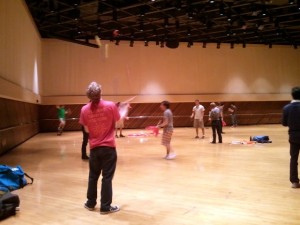
Junne Park, Photo Editor
The fact that practice space on campus for performance groups is a limited, highly sought commodity comes as little surprise to most.
The fraught space crunch issue came to a head, however, after changes made to the system for reserving spaces this summer resulted in confusion and frustration among several performance groups in recent weeks. The invested parties aired their grievances and offered feedback for improvements at a Dance Summit forum on Wednesday, Sept. 26.
Under the old system, performance groups could reserve space on campus for the upcoming academic year through the online Event Management System (EMS) during the first two weeks of June. However, due to construction on O’Brien Hall, which was unfinished at the time, and a professed desire on the part of the administration to better accommodate the needs of performance groups, the system was changed this summer.
Rather than fill out the form online, groups submitted forms to Wilson Commons Student Activities (WCSA) expressing preferences for the date, time and place for rehearsals and meetings and were assigned spaces and times for the fall semester, rather than for the entire year as previously done. Requests for large shows and programs was conducted on paper this spring as in years past.
Such information has never before been collected, according to Director of Wilson Commons Laura Ballou, who presented information about the new system at the Dance Summit and this week met with Students’ Association Senators to hear the concerns of performance groups as brought to the attention of the SA.
For the first time, Bridge Lounge was not an option for performance groups, primarily because it was never intended to be used as a rehearsal space and administrators wanted to return it to its original function as a lounge, Ballou said. The net number of available rooms did not change, however, because of the addition of two new spaces in O’Brien Hall — a 20-foot by 43-foot dance studio and a 13-foot by 29-foot music room.
“We wanted to really look at space utilization because we know that we have limited availability for dance performance groups,” Ballou said.
Due to unforeseen logistical difficulties, however, many student groups were not made aware of their allotted practice spaces until as late as last week, which has incited some ire among performance groups.
“We didn’t meet our timeline goals,” Ballou said. “It took a little longer than expected to go through all of the information.”
The times that groups were notified varied from the week of Orientation to last week, according to Ballou. She said that they had hoped to notify all groups of their preliminary eight-hour allotment by the week of Orientation, after which groups would be able to request more hours. The process ended up running about two weeks behind this ideal schedule, however.
Also new this year was the fact that those involved in booking space for athletic groups worked with Wilson Commons, as many of the rooms available for dance groups to practice in are also used by club sports and other athletic groups. In the past, groups submitted requests to each reservationist independently both through paper and through EMS and requests were looked at in conjunction if it was a space also used by dance groups.
“While they have always had general communication, they were not jointly looking at the overall requests,” Ballou said.
Ballou added that the problem of the delay in notification was compounded by the difficulties of trying to implement a new system over the summer, but stated that she believes the reasons behind implementing the new system had merit and that the administration is fully willing to work with groups both to improve space assignments for the immediate future and for coming years.
SA Chair of the Policy & Review Committee and sophomore Aditi Simlote said that she thought much of the frustration was a result of when groups received schedules, not the new system per se. She also agreed with Ballou that while space on campus is always a consideration, the net number of rooms available on campus did not change, so the main issue is the fact that groups apply for spaces at the same times.
“There are enough rooms for dance groups, it’s just that they want to use them at the same time,” Simlote said. “Like with any new system, there were bound to be errors. It was an unintentional delay.”
SA Senator and senior Shiv Rambarran said that he thinks the new system “is tending in the right direction” because of its aim at fostering equity among groups, but that it could be improved upon by the administration communicating changes better and by students transitioning executive boards members to be more familiar with the new system as well as staying on top of changes that are communicated.
“I think the issue was in its execution with regards to how the changes were communicated to groups and the timeframe that it took to complete,” Rambarran said. “However these are concerns that the administration is very much aware of and, based off student feedback, is already taking steps to address.”
President of Strong Jugglers and senior Stefanie Milner said that the changes definitely impacted her group, but did not present as vexing an issue as for other organizations. Milner said the main issue was the timing used to put it in place; she submitted reservation requests using the EMS system before finding out that she needed to use the new forms.
She said the Jugglers found out shortly before the Fall Activities Fair, earlier than some groups, though still frustrating, although the Jugglers received the spaces they requested and times that were slightly off what they had asked for but that still “work just as well.” The Jugglers are somewhat more limited than other groups in where they can rehearse and prefer the May Room because of its size and its lighting.
President of Ballet Performance Group (BPG) and senior Marisa Straub said that BPG has been heavily impacted by the new process and that it has caused BPG’s executive board “some major stress.”
“We have been scrambling for space and still don’t have the times and spaces that we originally requested, but we are making do,” Straub said.
BPG is currently practicing in the May Room for its largest dances and the Leibner Cooper Room and the dance studio in O’Brien Hall for others. Straub said they did not request the studio in O’Brien and that it is “a little small for the number of dancers in those pieces.”
Straub said she thinks that it makes sense to use paper reservation forms, but that the time it takes for them to be approved is a “little ridiculous,” especially since they did not find out until after rehearsals had already begun this semester.
“I think the real issue here was the lack of communication between the administration and the dance groups,” she said. “We really don’t rehearse at the same times. Our schedules worked perfectly fine last year, but the fact that we didn’t know this drastic change was coming our way was and still is very stressful.”
President of Louvre and senior Sarah Canny said that Louvre was not impacted as badly as some other groups, but still “experienced many frustrations with the new system” this fall.
Louvre rehearses 12 hours per week and needs spaces large enough to accommodate the group and the dances it performs, Canny said. The group prefers to practice in Spurrier Dance Studio where they hold shows, she said.
According to Canny, Louvre did not receive any information about a fall practice schedule until a week after classes started after having to go ask on the first day of rehearsals.
“Very slowly over the following two weeks our requests were processed, and we were eventually given most of the days and times we asked for, but not the spaces we requested,” she said.
Louvre did not receive Spurrier for any of its rehearsals, despite listing it as its first preference, and instead was given the new studio in O’Brien Hall for three out of four rehearsal days, Canny said, describing O’Brien as a “very nice studio,” but one that is “simply not big enough to accommodate our needs.”
Canny also said that she does not think that the main issue is the fact that all groups want the same days at the same times, as the groups were able to coordinate with each other to use generally the same rehearsal times every year — a process that functioned relatively seamlessly under the old system.
“Part of the issue is definitely that there is not enough space, but it has been manageable in the past and the addition of O’Brien has certainly improved that,” she said. “A major part of the problem is a lack of communication on the administrative level. While
I know they were trying to make the system better for us, they ended up not hearing any of our needs and actually making it more difficult for us to get what we need.”
Canny added that following the Dance Summit, she felt the administration was listening to feedback and taking suggestions.
“This is something we really appreciate, and we hope that change in the system can be accomplished,” she said.
Buletti is a member of the class of 2013.




